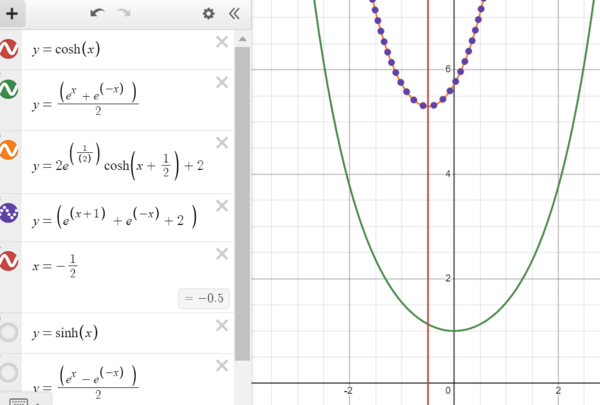2024 AMC 12A Problems/Problem 13
Contents
Problem
The graph of ![]() has an axis of symmetry. What is the reflection of the point
has an axis of symmetry. What is the reflection of the point ![]() over this axis?
over this axis?
![]()
Solution 1
The line of symmetry is probably of the form ![]() for some constant
for some constant ![]() . A vertical line of symmetry at
. A vertical line of symmetry at ![]() for a function
for a function ![]() exists if and only if
exists if and only if ![]() ; we substitute
; we substitute ![]() and
and ![]() into our given function and see that we must have
into our given function and see that we must have
![]()
for all real ![]() . Simplifying:
. Simplifying:
\begin{align*} e^{a-b+1}+e^{-(a-b)}-2&=e^{a+b+1}+e^{-(a+b)}-2 \\ e^{a-b+1}+e^{b-a}&=e^{a+b+1}+e^{-a-b} \\ e^{a-b+1}-e^{-a-b}&=e^{a+b+1}-e^{b-a} \\ e^{-b}\left(e^{a+1}-e^{-a}\right)&=e^b\left(e^{a+1}-e^{-a}\right). \\ \end{align*}
If ![]() , then
, then ![]() for all real
for all real ![]() ; this is clearly impossible, so let
; this is clearly impossible, so let ![]() . Thus, our line of symmetry is
. Thus, our line of symmetry is ![]() , and reflecting
, and reflecting ![]() over this line gives
over this line gives 
~Technodoggo
Solution 2 (Graphing cheese)
Consider the graphs of ![]() and
and ![]() . A rough sketch will show that they intercept somewhere between -1 and 0 and the axis of symmetry is vertical. Thus,
. A rough sketch will show that they intercept somewhere between -1 and 0 and the axis of symmetry is vertical. Thus,  is the only possible answer.
is the only possible answer.
Note: You can more rigorously think about the solution by noting that since the derivative of the power that e is raised to in one equation is equal to the derivative of the power that e is raised to multiplied by ![]() and both equations are subtracted by 1, then the sum of both equations will be the same from one side of the interception to the other. Setting both equations equal to each other, it is trivial to see
and both equations are subtracted by 1, then the sum of both equations will be the same from one side of the interception to the other. Setting both equations equal to each other, it is trivial to see ![]() , giving us the axis of symmetry.
, giving us the axis of symmetry.
~woeIsMe
![[asy] unitsize(2cm); real e = 2.71828; real f1(real x) {return e^(x+1)-1;} real f2(real x) {return e^(0-x)-1;} draw(graph(f1,-1.5,0.5)); draw(graph(f2,-1.5,0.5)); xaxis(-2,1,Ticks()); yaxis(f2(0.5),f1(0.5),Ticks()); draw((-0.5,f2(0.5))--(-0.5,f1(0.5)),red+dashed); /*graph by Technodoggo, 9 November 2024*/ [/asy]](http://latex.artofproblemsolving.com/9/f/1/9f1a518b59aea933966867fead0277994d114076.png) (graph by Technodoggo)
(graph by Technodoggo)
Solution 3 (Derivatives)
Since y is a proper function of x, the axis of symmetry is vertical. Where a function crosses a vertical axis of symmetry, it must have a vertical asymptote (clearly impossible for this given function, since linear functions and exponential function are total functions), or a local maximum or minimum (derivative 0).
So the derivative is equal to 0:
![]()
To solve for ![]() , make a substitution:
, make a substitution:
![]()
![]() ->
->
![]() ->
->
![]() ->
->
![]() ->
->
![]() ->
->
![]() ->
->
![]() ->
->
![]() Now we just flippidy flap (-1,
Now we just flippidy flap (-1, ![]() ) over
) over ![]() and blammo, we got ourselves the answer choice
and blammo, we got ourselves the answer choice 
Solution 4
![]()
![]()
![]()
![]()
so f(0) = f(-1) , f(1) =f(-2)
then f(x) is symmetric about x=-1/2
point (-1, 1/2) reflects over axis x=-1/2 is point ( 0, 1/2) answer choice D
~luckuso
Solution 5
Notice that this is simply a transformation of ![]() , specifically
, specifically ![]() . We know that
. We know that ![]() has a parabolic shape with an axis of symmetry
has a parabolic shape with an axis of symmetry ![]() . Since this is simple a transformation of
. Since this is simple a transformation of ![]() to the left of the origin, we have the axis of symmetry is
to the left of the origin, we have the axis of symmetry is ![]() giving us
giving us 
~KEVIN_LIU
Solution 5 (Graph)
Solution 6
![]()
So the axis is ![]()
Point ![]() reflects over the axis
reflects over the axis ![]() to the point
to the point 
Solution 7
Setting the axis of symmetry as ![]() implies
implies ![]()
![]()
Analyzing the terms ![]() and
and ![]() tells us that
tells us that ![]()
This reveals that ![]()
Finally, point ![]() reflected over the axis
reflected over the axis ![]() is the point
is the point 
See also
| 2024 AMC 12A (Problems • Answer Key • Resources) | |
| Preceded by Problem 12 |
Followed by Problem 14 |
| 1 • 2 • 3 • 4 • 5 • 6 • 7 • 8 • 9 • 10 • 11 • 12 • 13 • 14 • 15 • 16 • 17 • 18 • 19 • 20 • 21 • 22 • 23 • 24 • 25 | |
| All AMC 12 Problems and Solutions | |
The problems on this page are copyrighted by the Mathematical Association of America's American Mathematics Competitions. 










